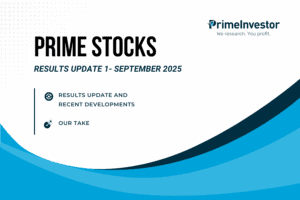“Behind every stock, there is a company (business)” – Peter Lynch
This statement by Peter Lynch may seem too obvious to count as a quotable quote. But when investors have been pocketing easy gains from a trending bull market, it is easy to focus on stock prices and lose sight of the businesses that are powering them. In 2025, investors may get frequent reminders of Peter Lynch’s quote.

Equity Market in 2024 – A rewind
When we wrote our 2024 outlook at Nifty 21500, we expected equity market returns to be front-ended with a correction likely to unfold in the second half of 2024, on the back of a moderation in growth.
The markets remained resilient for the first eight months of the year, prompting us to revisit our view in early September 2024. We reiterated that markets were pricey, that a moderation was already underway and that it was safer to take shelter in large-caps. We believed that Nifty earnings could still expand 12-15%.
The growth moderation did play out. Large-caps launched into a correction from September 2024, while mid-caps and small-caps have lately followed.
There was also sharp divergence in returns between sectors. The tables below show the key leaders and laggards of 2024, with their current valuations.
As we head into 2025, more challenges loom over equity markets than was the case in 2024. These are:
- US President Trump’s policies
- Uncertain rate outlook
- Slower corporate earnings growth
- Volatile stock market liquidity
These are inter-dependent factors with one having an impact on the other.
The “Trump Trade” positioning of global markets seems to be the main challenge to markets heading higher right now. With Trump blowing hot and cold on policies relating to inflation, interest rates, emigration and trade, global investors have been in risk-off mode, waiting to see how his actual policy actions will pan out.
Meanwhile, after cutting rates by 100 basis points since September 2024, the US Fed seems to be rethinking its monetary easing, after US economic data has consistently surprised on the upside. This has caused US treasury yields to move in the opposite direction from Fed actions, with both the 2 year and 10-year treasury rising back towards 5%. A strengthening US dollar has added to the US markets’ attractiveness.
In contrast, GDP growth in India is expected to cool from 8.2% in FY24 to 6.4% in FY25. Corporate earnings growth has slowed to single digits in the June and September quarters of 2024.
All this has caused FPIs to indulge in a selling spree in Indian stocks, to reallocate money to the now-attractive US treasuries. As FPIs are dominant shareholders in the index names and large-caps, large-caps have led the market fall, declining more than mid-caps and small-caps so far. DIIs have been sitting on cash and seem hesitant to jump in at these levels, due to high valuations and uncertainty on earnings.
Indian markets from September 2024 have been riding on a single pony, which is inflows from retail investors. A large part of this liquidity is getting channelised into MFs and IPOs. But the question is if this retail optimism will continue, if markets stop delivering double-digit gains and revert to their more usual pattern of two-way moves.
For long term equity investors today, there is little point in trying to figure out Trump policies, US Fed or other macros. Nor can they predict liquidity. Therefore, the only way to make good equity gains in 2025 would be to tune out all this noise and retain a laser focus on the sectors and stocks that can still deliver earnings growth.
Equity outlook for 2025
Our view for the year ahead is as follows:
#1 Nifty earnings to slow
In our view, earnings growth at the broader market level will slow sharply in FY26, aligning more with nominal GDP growth (which is expected to be in the 9-10% range). Nifty EPS growth has doubled between FY20 & FY24, largely led by cyclical sectors.
Going forward, the Nifty50 EPS will no longer have support from commodities, or capex-dependent core economy sectors. We expect financials and consumption-oriented sectors to carry Nifty earnings, just about getting its earnings growth to 10%. Volatile FPI liquidity, along with a moderation in domestic liquidity could see market multiples moderate to 18-20 times. The table below models Nifty50 levels based on different scenarios for earnings growth and valuations. The more likely scenarios in our view are marked in yellow.
Here’s our expectation on earnings growth for FY26 and how valuations stack up
We think it likely that, barring any Black Swan events, a Nifty50 correction would halt at lower band highlighted in the table (20,790 @18X) while the best-case scenario may see the Nifty head to 26,565 (15% growth @22X).
#2 Bigger downside in small and mid-caps
The correction so far has brought stock prices and valuations in closer alignment for large-cap stocks. But the gaps remains huge for small-caps and to a larger extent, mid-caps. Scorching earnings growth rates of 30-40% CAGR in the last four years has propped up valuations of the Nifty Midcap and Small-cap indices to 43 times and 34 times respectively.
We think the Mid-cap 150 is the more risky pocket at this point of time. It has accommodated stocks from the hottest sectors of the post Covid era, be it new-age companies, capital market firms, electronics manufacturing, renewable energy or hospitality, healthcare services and defence PSUs. Small-caps can also have material downside. But the high market cap bar for small-caps today (> Rs 11,000 crore) and the large universe of stocks that make up this segment will offer opportunities for selective bets in the year ahead.
#3 Equity returns to be back-ended
We expect stock market returns in 2025 to materialize mainly in the second half. Major sectors that can expected to deliver growth such as banking, IT services, auto and consumer, are facing near-term headwinds which may abate once there is clarity on Trump policies and rate cuts. Here is our sector-wise expectation.
- Banking: Near-term earnings will slow on margin pressures, liquidity crunch and slow retail credit offtake. But the sector’s sharp underperformance suggests less room for disappointments. Even a shallow easing cycle can temper cost of funds and improve credit offtake.
- IT Services: The IT sector was the first to slowdown in FY23. But it seems to be improving now on a pickup in global IT spending. The US economy avoiding a recession and surprising on growth, along with USD strength is positive for the sector.
- FMCG: September quarter results have fanned slowdown fears but rural demand seems to be picking up.
- Auto: Automobiles have just entered a cyclical slowdown after two years of stellar growth, but there could be pockets of opportunity if financing costs moderate.
- Discretionary consumption: Discretionary consumption has been hit by RBI curbs on consumer credit and high rates, but any Budget measures to boost consumption and rate cuts can revive this sector.
- Pharma: While global pharma majors are facing a pricing issue on generic drugs, export opportunities offer potential.
# 4 Time for bottom-up investing
There are NO pockets of under-valuation in the Indian equity markets heading into 2025. This is at a time when both the economy and aggregate earnings are slowing down. This is why think Peter Lynch’s reminder that “behind every stock, there is a company” holds significant relevance for 2025.
With very few sectors allowing entry at fair valuations, a top-down approach may not yield results for stock investors this year. Simply piggybacking the indices may also not deliver results. Even if you can identify sectors that offer a better risk-reward, we expect significant divergence between players in terms of growth and quality within sectors. This suggests that following a stock specific approach will pay off across sectors while than buying indices or sectors as a whole, won’t.
For instance, even within decently valued sectors such as banks, there is emerging stress on asset quality in the unsecured lending book. At PrimeInvestor, we hope to navigate this through a stringent focus on quality names. We believe this is not a sector that is suitable for bottom fishing on falling stocks, especially when the correction is due to asset quality issues. We have HDFC Bank in our buy list because its problem is not an asset quality problem, but a credit-deposit mismatch. Asset quality problems lead to NPA write-offs and equity dilution, and is a slippery slope. In IT, we see a likely divergence between the Tier 1 players and Tier 2 players this year.
What PrimeInvestor will do
Broadly therefore, we will be bucketing sector opportunities in 2025 as follows.
#1 Where value meets growth
In this bucket we will look at the following sectors that offer a combination of fair valuations with decent growth prospects.
- Lenders – Banks & NBFCs
- Large cap IT services
- FMCGs
- Agriculture and rural themed stocks
- Proxies for the real estate sector
In these sectors, understanding the pockets of growth with fewer risks, can help identify stocks with good risk-reward. We will focus on identifying such opportunities at the right time for you.
#2 High-Potential but High-Risk: Emerging Sector Opportunities
We believe the following nascent sectors offer the lure of a large addressable market, but trade at rich valuations that assume almost every player will succeed.
- Quick commerce
- CDMO
- Electronics manufacturing
In reality, such sectors may have only a few survivors. In Quick Commerce, CDMO and electronics manufacturing for instance, reams have been written about the very large size of the opportunity and that is driving the excitement around valuations. But the unknown is, which players will deliver long-term value creation with sustainable profitability and healthy RoCE. Barring 1 or 2 companies in each of these spaces, others are unlikely to make the cut.
All these sectors call for exceptional level of execution due to the complexities involved in terms of capital investment, regulations, changing government policy and intensity of competition. Anyone looking to hunt in these spaces must investigate these factors in-depth at these valuations. Owning high growth stocks is important for retail portfolios for a shot at multi-bagger returns. That’s why we will track these spaces but be selective, avoiding firms whose valuations factor in best-case outcomes.
#3 Peak Cycle Sectors: Managing Cyclical Risk
These are sectors with cyclically high earnings, where valuations have also turned pricey, as markets expect cyclically high growth to continue. We will tread these with caution.
- Hospitality
- Defence/ Rail/Industrial goods
- Automobiles
We would exercise caution while picking stocks from these sectors as there is little margin of safety. For instance, in hospitality, the more market values deviate from book value, the more the attraction for new capacities to come up. This attracts new players to go on a room addition binge, forcing existing players to add capacities to defend their market share. All this eventually leads to over-supply and a sharp fall in tariffs, margins and occupancies until the sector can self-correct. Any such correction would prompt us to pick stocks selectively.
The year ahead looks exciting for our research team, especially since a rising tide won't be lifting all boats this time around. But we think it should help analysts like us who believe in the power of business fundamentals, earnings and management quality to drive stock performance. We're looking forward to finding those hidden opportunities for you.
As always, we would strive to alert you to these opportunities through the stock and mutual fund route. On your side, we would request you to stay tuned to our alerts - whether it is buy,hold, sell or book profits and keep in portfolio in great shape!




17 thoughts on “Prime Equity Outlook 2025”
Excellent analysis, can you please do an analysis on emerging and worry trend about micro-financing loans in banking and NBFC. Unfortunately, i invested in Ujjivan, Creditaccess Grameen, IDFC, all these have posted very poor results. Not sure if this is because of a broader stress in micro financing?
Excellent report and analysis, In this case should we not change asset allocation, more to Debt and Balanced advantage funds? I see the reply stick to asset allocation, but is it not better to be conservative, Also -3000 points you are flagging as a downside risk, which is -13% approx, which means the downside risk is not massive in Nifty (massive is >20%), so should one not change allocation from mid cap to flexi caps/large?
Please do rebalancing wherever your allocation is significantl inflated from original allocation. For example, if midcap went from 10% to 15% naturally your equity would be up by that proportion or more. So in such cases, the idea is to move to different asset class as equity itself would be inflated. Vidya
Very good analysis. Wishing the team a wonderful 2025.
Given the analysis that the sector as a whole won’t give good returns, should one pause their SIPs in mutual funds and invest on individual stocks recommended by Prime Investor.
SIPS in mutual funds is to build wealth for specific goals. Stocks can only top it. They cannot help make disciplined investments. Vidya
thank you . this a very good article. helps in structural thinking and how to filter out noises.
Thanks!
For 2025,can we increase the exposure to debt funds or move to bond markts as Q3 earnings are going to below avg.
Please stick to your original asset allocation and recuce (book profit) whenever any of the asset class becomes inflated and deploy in the asset class that is deflated. This will automatically ensure you are not sitting on excess bubble. Do not try to create new asset allocation for every market. thanks, Vidya
Thanks Vidya for the guidance
Thanks, team for the insightful report. I have a question on the recent addition of ‘HDFC Pharma & Healthcare’ fund in the Prime Funds while drawing parallels with this report.
Per this report, “Pharma: While global pharma majors are facing a pricing issue on generic drugs, export opportunities offer potential.”
My current exposure to Pharma via active non sectoral funds is about 8.5 %.
Question – Should i increase exposure to Pharma and make it somewhere between 10-15% in the first half of the year? If yes, then should i increase it in the Jan-March quarter, or wait for deeper corrections in this sector? TIA!
This is not an advice but I think you should not up exposure to a single sector to 10-15% in terms of prudent allocation. If you choose to, please do it in phases (not SIPs but on corrections). Vidya
We continue to have faith on your research , and hope this challenging year brings out the best in you.
Thanks. we hope so too 🙂 Vidya
Therefore, the only way to make good equity gains in 20255 would be to tune out all this noise and retain a laser focus on the sectors and stocks that can still deliver earnings growth.
Please correct the year 20255 in the report.
Thanks for pointing it out, this has been corrected. – regards, Bhavana
Comments are closed.